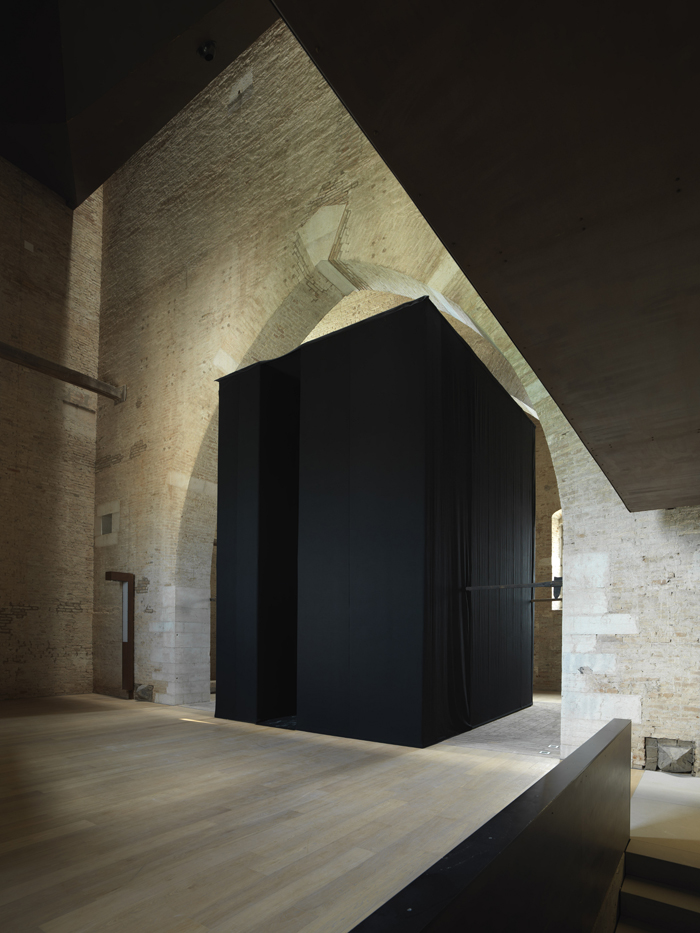To arrive at the Arsenale Nord one must take a boat. As I step from the quay, the frenetic, madding opening week bustle of the Arsenale is left behind. There is no sense of loss. A light drizzle is in the air and I feel as though I’m on a pilgrimage towards tranquility and peace, crossing the river to my salvation. I’m going to see the work of Shirazeh Houshiary.
Shirazeh’s work for the 55th Biennale di Venezia, Breath is a collateral event housed in La Torre di Porta Nuova. Built between 1809 and 1814 to enable the mechanical placement of masts onto ships, it is a building of almost ecclesiastically monumental proportions and presence. Breath is a four channel video and sound installation that features soft but captivating voices.
There is one chant for each of four major religious traditions: Buddhist, Christian, Jewish and Islamic. The work’s positioning couldn’t be more fortuitous. The two, looking out together over the water, enhance each other perfectly.
From the outside Breath announces itself as an immense fabric box. Made from black felt, its sides soar upwards as far as the archway it inhabits. Sunlight beams down from above onto its muted surface. At the front there is a shoulder width gap through which it is clear the viewer is invited to enter. Visibility is limited as one passes down a short, narrow passage. There is very little light either natural or artificial, only that which seeps in from outside
Inside is an intimate, square space. As my retinas adjust to near darkness, four small video screens slowly become apparent at eye level. The sound that welcomes me is an enticing, but unclear overlaying of four different incantations. As I approach each screen in turn, one of the four chants becomes more clear, but it is never possible to hear one without registering the other three. The sounds are fused together, inherently inseparable before they reach the ear. The source of the audio is lost somewhere in the darkened space. Do they originate from the ear, the brain, or in the space between the speakers and myself? Like the breath, these sounds are hardly tangible. No sooner are they perceived than they are gone, transformed into something else.
On the screens I see what appear to me as specks of light floating and pulsating in abstract, centrifugal formations. Their movement evokes something of the astronomical realm. It’s almost as though I’m outside the universe looking in, watching it in miniature, expanding and contracting. The spaces between the dashes of light grow larger and then smaller again.
Involuntarily I throw my head back and look up as one might beneath the dome of a cathedral. In the semi-darkness I can’t make out an ending to this temporary vaulted structure. The four black walls fly upwards into an apparent infinity. The space has no edges, as if there were no limit to its bounds.
What I find most compelling is that this work seems to point towards commonality and that energetic oneness that permeates every being, living and nonliving. It is something of a surprise that Shirazeh Houshiary’s Breath should find itself at la Biennale di Venezia—the home of competitive, jingoistic individuation.
So subtle is this work, and so persuasive, that I begin to question the wisdom of the Biennale’s artistic nationalism. At a time when borders are in a constant state of actual, philosophical, and metaphorical transgression, and the transfer of communication and knowledge take place almost exclusively via a rhizomatic hyper-network, the notion of a meaningful space existing for national pavilions begins to seem absurd.
By Beverly Knowles

























One Response to Shirazeh Houshiary’s Breath At the 55th Biennale di Venezia